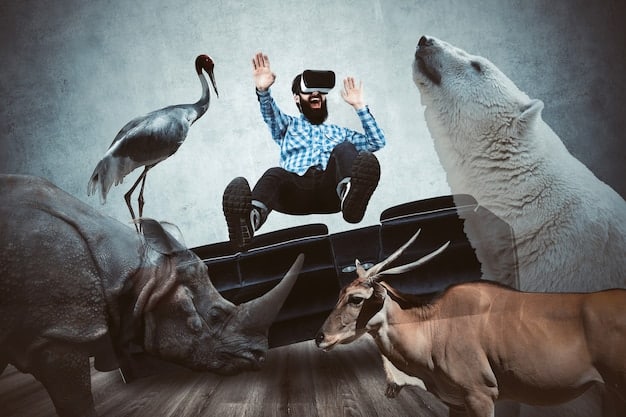The Evolution of Movie Trailers: US Audience Attention in 2025

The evolution of movie trailers in the US by 2025 will leverage AI-driven personalization, interactive formats, and immersive experiences to captivate audience attention and drive box office success.
In the rapidly evolving landscape of entertainment, the evolution of movie trailers: how US studios are capturing audience attention in 2025, marks a significant shift from traditional marketing methods to innovative strategies that resonate with digitally savvy viewers.
The Shifting Landscape of Movie Trailers
Movie trailers have long served as a critical marketing tool for studios, whetting audience appetites and driving ticket sales. However, the way these trailers are created and consumed is undergoing a dramatic transformation. This section explores the key factors driving this evolution.
The Impact of Streaming Services
Streaming services have revolutionized how movies are consumed. Consequently, trailers must now compete for attention in a fragmented media landscape, necessitating more creative and targeted approaches to reach potential viewers.
Declining Attention Spans
With shorter attention spans becoming the norm, US studios are under pressure to create trailers that can quickly capture and maintain audience interest. Trailers must be concise, visually stunning, and emotionally engaging to break through the noise.

Here are some crucial trends shaping the future of movie trailers:
- Personalized Trailers: AI and data analytics enable studios to tailor trailers to individual viewer preferences.
- Interactive Experiences: Trailers now incorporate elements of gaming and user choice, enhancing engagement.
- Shorter Formats: Trailers are becoming shorter and more impactful, designed to grab attention instantly.
As technology advances and audience expectations shift, movie trailers must adapt to remain effective. The future of trailers lies in personalization, interactivity, and brevity.
AI-Driven Personalization in Trailers
Artificial intelligence is playing an increasingly important role in the creation and distribution of movie trailers. AI algorithms can analyze vast amounts of data to understand audience preferences and optimize trailers for maximum impact. This section dives into how AI is being used to personalize the trailer experience.
Data-Driven Trailer Creation
AI can analyze viewer behavior to identify the most appealing scenes, music, and editing styles for different audience segments. This data is then used to create trailers that are highly targeted and effective.
Dynamic Trailer Editing
Imagine a trailer that changes in real-time based on your viewing history. AI makes this possible by dynamically editing trailers to emphasize elements that are most likely to resonate with individual viewers.
Here’s how AI is transforming trailer personalization:
- Predictive Analytics: Forecasting audience reactions to different trailer elements.
- Automated Editing: Generating multiple trailer versions tailored to various demographics.
- Personalized Recommendations: Serving trailers based on individual viewing habits and preferences.
AI-driven personalization is revolutionizing how movie trailers are made and distributed, ensuring that viewers see trailers tailored to their unique tastes.
Interactive and Immersive Trailer Formats
To combat declining attention spans and enhance engagement, studios are experimenting with interactive and immersive trailer formats. These formats allow viewers to actively participate in the trailer experience, fostering a deeper connection with the movie.
Choose-Your-Own-Adventure Trailers
Interactive trailers that allow viewers to make choices and explore different plotlines are becoming increasingly popular. These trailers create a sense of agency and investment, encouraging viewers to learn more about the movie.
Virtual Reality (VR) Trailers
VR trailers offer an immersive cinematic experience, transporting viewers directly into the world of the movie. These trailers provide a unique and engaging way to preview upcoming releases.

Discover the key features of interactive and immersive trailers:
- Enhanced Engagement: Viewers actively participate in the trailer experience.
- Deeper Connection: Interactive elements foster a stronger emotional connection with the movie.
- Unique Previews: VR trailers offer a one-of-a-kind cinematic experience.
Interactive and immersive trailer formats are transforming the viewing experience, making trailers more engaging and memorable for audiences.
The Rise of Micro-Trailers
In an era of fleeting attention spans, micro-trailers—ultra-short previews lasting just a few seconds—are gaining traction. These bite-sized snippets are designed to grab attention quickly and effectively on social media platforms.
Content-First Marketing
Micro-trailers focus on delivering impactful content in a short timeframe. They highlight the most exciting and visually appealing moments of the movie to pique viewer interest.
Social Media Optimization
Designed for platforms like TikTok and Instagram, micro-trailers are optimized for mobile viewing and shareability. They often feature trending sounds and visual effects to increase their reach.
Here’s how micro-trailers are changing the game:
- Instant Impact: Delivering key movie highlights in seconds.
- Mobile-Friendly: Optimized for viewing on smartphones and tablets.
- Viral Potential: Designed to be easily shared on social media platforms.
Micro-trailers are becoming an essential tool for studios looking to reach audiences in an increasingly fast-paced digital world.
Data Analytics and Audience Insights
Data analytics plays a crucial role in understanding audience behavior and optimizing movie trailer performance. By analyzing viewing patterns, engagement metrics, and social media sentiment, studios can gain valuable insights to improve their marketing strategies.
Understanding Viewer Preferences
Data analytics helps studios understand what viewers are looking for in a movie trailer. This information is used to tailor trailers to meet specific audience preferences and expectations.
Optimizing Trailer Performance
By tracking key metrics such as view counts, click-through rates, and social media engagement, studios can identify areas for improvement and optimize their trailers for maximum impact.
Explore the benefits of data analytics in trailer marketing:
- Targeted Marketing: Reaching the right audience with the right trailer.
- Improved Engagement: Creating trailers that resonate with viewers.
- Data-Driven Decisions: Making informed marketing choices based on audience insights.
Data analytics empowers studios to create more effective movie trailers that connect with audiences and drive ticket sales.
The Future of Movie Trailer Music and Sound Design
Music and sound design are integral components of movie trailers, creating atmosphere, building tension, and evoking emotion. The future of trailer music will likely involve more personalized and dynamic approaches, leveraging AI to create custom soundtracks that resonate with individual viewers.
Personalized Soundtracks
AI algorithms can analyze a viewer’s music preferences and generate custom trailer soundtracks that align with their tastes. This creates a more engaging and personalized viewing experience.
Immersive Sound Design
Advanced sound design techniques, such as spatial audio, are being used to create immersive trailer experiences that envelop the viewer in the world of the movie. This enhances the emotional impact and makes the trailer more memorable.
Here’s what to expect from the future of trailer audio:
- Dynamic Soundtracks: Music that adapts to the viewer’s preferences in real-time.
- Spatial Audio: Immersive sound design that creates a sense of presence.
- Emotional Resonance: Music and sound that evoke powerful emotions and enhance engagement.
The evolution of movie trailer music and sound design will play a crucial role in captivating audiences and driving movie interest.
| Key Point | Brief Description |
|---|---|
| 🎬 AI Personalization | Trailers tailored to individual viewer preferences via data analytics. |
| 🎮 Interactive Formats | Choose-your-own-adventure and VR trailers enhancing audience engagement. |
| 📱 Micro-Trailers | Short, impactful previews optimized for social media platforms. |
| 📊 Data Insights | Using analytics to understand viewer behavior and optimize trailer effectiveness. |
Frequently Asked Questions
▼
AI is enabling personalized trailers by analyzing viewer data to tailor content, music, and editing to individual preferences, enhancing engagement and relevance.
▼
Interactive trailers allow viewers to make choices that affect the storyline, offering a more engaging and immersive preview experience, fostering a deeper connection to the movie.
▼
Micro-trailers are short, attention-grabbing previews designed for social media, capturing viewer interest quickly and effectively in a fast-paced digital environment, maximizing shareability.
▼
Studios use data analytics to understand audience preferences and optimize trailer performance, tracking metrics like views and engagement to improve marketing strategies and connect with viewers.
▼
Music in modern trailers creates emotion and builds tension. AI-driven personalized soundtracks enhance viewer engagement, while immersive sound design provides a deeper cinematic experience.
Conclusion
As US studios navigate an evolving media landscape, the integration of AI, interactive formats, and data analytics is revolutionizing movie trailers. These advanced strategies not only capture audience attention but also create more personalized and immersive experiences, setting the stage for a future where trailers are as engaging as the movies they promote.





